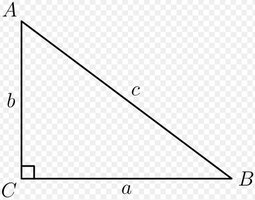DearLindsay
New member
- Joined
- Sep 15, 2022
- Messages
- 1
Hello everyone just wondering if I stumbled upon a proof for the pythagorean theorem or not Ill try to explain as best I can but I don't really have any experience in formulating proofs. Im also really bad at maths so Im just sorry for what will probably a terrible reading experience. I was just messing around and decided to see if I could prove the pythagorean theorem. It actually took me a long time to get to this but I don't know if its correct honestly. If people ask questions Ill try my best to provide actually rigorous answers lol. Thanks.
Edit: Ok so I realized this doesn't actually work lmao but its still kinda close I guess. If anyone can explain why thats would be nice.
Let ABC < be any right triangle, let DEF < be an identical right triangle. Put the two together as to make a rectangle in which D and C and F and A are common points. Draw the diagonals of the rectangle and let P be the point of intersection between them. Let point G be the middle of segment EC/ED (same thing just to be clear). Draw a straight line between point P and point G. Extend the line as to create a rhombus CPEH in which the diagonals are EC and PH (this should make two congruent triangles atleast I think so). Repeat the process as to create a rhombys for each of the 4 sides of the original rectangle. Calculate the area of the rhombus CPEH by multiplying the diagonals and multiply the product by two. This would be the area of the rectangle created of the two rhombuses which rests upon the hypothenuse. This area should always be equal to the other rectangle created by the other two rhombuses. Thus C^2=A^2+B^2 QED.
Edit: Ok so I realized this doesn't actually work lmao but its still kinda close I guess. If anyone can explain why thats would be nice.
Let ABC < be any right triangle, let DEF < be an identical right triangle. Put the two together as to make a rectangle in which D and C and F and A are common points. Draw the diagonals of the rectangle and let P be the point of intersection between them. Let point G be the middle of segment EC/ED (same thing just to be clear). Draw a straight line between point P and point G. Extend the line as to create a rhombus CPEH in which the diagonals are EC and PH (this should make two congruent triangles atleast I think so). Repeat the process as to create a rhombys for each of the 4 sides of the original rectangle. Calculate the area of the rhombus CPEH by multiplying the diagonals and multiply the product by two. This would be the area of the rectangle created of the two rhombuses which rests upon the hypothenuse. This area should always be equal to the other rectangle created by the other two rhombuses. Thus C^2=A^2+B^2 QED.
Last edited:

